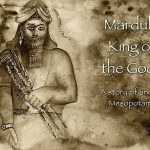Let’s make life easy in this opening line:
The biliteral root of Torah is *R’. The biliteral root of Talmud is *LM. The biliteral root of Quran is *GR > ●QR.
Gal is not a root but a triliteral (*G’ + l).
Historians who spent precious time attempting to find roots of immediate Islam in Yemen or southern Syria (Basra) may have looked in the wrong places. The advice of this writer to all researchers interested in Arabia, ancient Arabian language and Islam is to read Lisan Al Arab, the 13th century most comprehensive Arabic dictionary.
An entry quotes a prominent member of Qureish tribe, Mohammed’s tribe, that they came originally from Kutha (Cutha), an ancient city 40 KM northeast of Babylon. The city, originally Sumerian, was the centre of worship of Nergal. Several important words in the Quran are Sumerian and mostly via Akkadian.
Ignoring Arabia would be a mistake but tracing some of the major concepts in the Quran may lead the researcher to Babylon. The identification of words said to be Sumerian in eastern Christianity and Judaism may provide the researching hand with three initial birds not just one.
This became clear when IL was identified an Adite root of Elohim, Eli and Allah. Angel, Injeel (the New Testament in Arabic), jal jalaluh, a style of Allah, meaning “glory be to his glorious Self” and Nergal share the same Sumerian root gal.
Of Akkadian origin:
Torah (Adite root *Rʼ, “to see”): warû (2): [Transport] 1) to guide, to lead, to conduct, to show the way 2) G (u/u; imperative: [ru]; [uru],: [ri]): to lead, to conduct 3) (ventive): to fetch, to go for, to bring 4) Gtn: to guide, to steer, to show the way, to administer, to manage, to raise (children), to bring up (children) 5) Gt: to lead away for good 6) Š: to conduct, to direct (person, animal, boat…);
Talmud (Adite or A’adite root *LM “gather, group”):
talmīdu: 1) a school boy, a pupil, a student, a disciple, an apprentice; feminine: talmittu; 2): a kind of plough;
talmittu: [Education]: a female apprentice, a student / a pupil; masculine: talmīdu;
NEVI’IM (The Prophets):
nabû (From an Adite root *NB “plants that stand up, protrusion, elevated, distinguished himself/herself; found in Arabic ‘nabi’ “prophet”): G. to name (+2 acc.); to invoke (a god); to nominate; to decree, ordain D. to lament, wail Š. to cause to proclaim N. to be named; to be appointed, called upon
Resurrection
The concept of resurrection in religions was established before Hammurabi published his Code. His father was Sin-Muballit the fifth Amorite king of the first dynasty. Balāṭu in Akkadian is “life”. An extension of the word is balluṭu: revived, reanimated, resurrected / restored to life.
Sin the Akkadian is the Sumerian Nanna, god of the moon in the Mesopotamian mythology. The two seats of worship of the moon god were Ur in southern of Mesopotamia and Harran. Sin is described in the commonstream literature as “Semitic moon god Su’en/Sin”. This is like saying Luna was a Latin moon goddess.
Sin means ‘tooth’. People didn’t smoke in prehistoric times so their teeth were supposed to be white. Age was assessed according to the growth number of teeth. ‘Sana’ in Arabic is “year” from the same root *SN. The root is directly linked to the act of giving birth to human babies *NS. From this root is ‘nasl’ “offspring”, ‘nisa’ “women”, ‘insan’ “human being” as opposed to animals.
Muballit appears to be the subject or agent “the resurrector” Sin.
Doomsday
Doomsday or the Day of Judgement in the Quran is the day of resurrection (yum al baath – IPA bʻ ṯ, Roum 56 twice mentioned), that is when all human beings, some 100 billion according to some, are supposed to be resurrected to be judged. Another name of Doomsday is yum al deen. Deen is Sumerian “din_gir”.
50. U-dimmer-an-kia En-dinger-an-kia Marduk Merodach as “lord god of heaven and earth.”
http://www.sacred-texts.com/ane/rbaa.htm
The concept in Akkadian is mathematical: good deeds – bad deeds =? The word is nikkassu [NÍG.KA:] [Trade] account, property, possessions, wealth, funds, assets, statement of account [nikkassu šasā ‘ um]: to claim settlement of accounts: [nikkassu epē/āšu]: to balance accounts, to break even: [nikkassu ṣabātu]: to balance accounts, to break even [ina nikkassu šakānu]: to submit to accounting, to make something available for accounting [ina nikkassu]: at the time of accounting [rab nikkassu]: chief accountant, comptroller, administrator of property [bīt nikkassu]: counting house (Elam): result of calculation 2): [GIŠ.NÍG.KA9]: an emblem of Shamash [ūm epēš nikkassi]: the day of Judgement, Doomsday.
Nikkassu appears to be from the Yemeni root *GṢ with a category involving cement-like outside layers on mud or stone walls and white wash. *GṢ is the act of crushing white stones to produce the white wash material but used by northern Arabian with a ‘q’ substitution to mean “cut”. Cutting hands is a punishment hence ‘qaṣaṣ’. ‘nGaṢ’ is “subtract’. However if there’s consensus by speakers to mean the above it should mean just that.
Balancing accounts is a mathematical process of addition and subtraction. The day of accounts could be the end of the financial year when loss or profit is certified. The Day of Accounts in Islam is Doomsday or the day of Judgment – youm al Hissab (Ṣad 26, 53; Gafer 27).
Ṭupšīmātu
The “Louh mahfouth” (Lawḥ Maḥfōẓ), Burouj 22, is a record of everything or a record of destiny. This ‘protected board’ is Akkadian: ṭupšīmātu: [Religion → Myths] tablet of destiny / fate (where each one’s lot is already written).
In Mesopotamian mythology, the Tablet of Destinies (Sumerian: Dup Shimati); was envisaged as a clay tablet inscribed with cuneiform writing, also impressed with cylinder seals, which, as a permanent legal document, conferred upon the god Enlil his supreme authority as ruler of the universe.
In the Sumerian poem Ninurta and the Turtle it is the god Enki, rather than Enlil, who holds the tablet. Both this poem and the Akkadian Anzû poem share concern of the theft of the tablet by the bird Imdugud (Sumerian) or Anzû (Akkadian). Supposedly, whoever possessed the tablet ruled the universe.
In the Babylonian Enuma Elish, Tiamat bestows this tablet on Kingu and gives him command of her army. Marduk, the chosen champion of the gods, then fights and destroys Tiamat and her army. Marduk reclaims the Tablet of Destinies for himself, thereby strengthening his rule among the gods and becomes ruler of the universe.
http://en.wikipedia.org/wiki/Tablet_of_Destinies_%28mythic_item%29
Image: www.angelministriesfl.org – Ancient Arabians believed angels are the daughters of God.
Last modified: June 1, 2023



